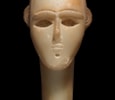Votive Head of a Man
Votive Head of a Man
C. 1st Century B.C. - 1st Century A.D., Yemen
27 x 14 cm (10 ⁵/₈ x 5 ¹/₂ inches)
Alabaster
Sold
This male head with an oval face surmounts a long neck. The nose is long and fine, the straight mouth is signified by a simple engraved line with raised small lips and a beard collar underlines the lower part of the face, along the chins. Large almond-shaped eyes are hollowed out and traces of stucco are still present, evidence of a past inlay. The eyebrow incisions were certainly enhanced with bitumen or stucco inlays. These representations embody the memory and the symbolic presence of the deceased and were probably were inserted in small cubic bases or in niches dug in the upper part of steles, bearing the name of the dedicant, within temples.
It has been suggested that this head originates from Ḥayd bin ʿAqīl, the cemetery of Tamnaʿ, the capital of the ancient kingdom of Qatabān.
Architectural Digest, November 1979
House & Garden, March 1985
John Richardson, John Richardson at Home, with photographs by François Halard, Oberto Gili, Horst and Derry Moore, Rizzoli, 2019.
Sotheby’s London, Ancient Sculpture and Works of Art, 17th December 2020, lot 73
John Richardson. A Scholar Collects, Sotheby’s 2020.
David Aaron Ltd, 2023, No. 26.
By repute from Ḥayd bin ʿAqīl, the cemetery of Tamnaʿ, the capital of the ancient kingdom of Qatabān.
Private Collection of Sir John Richardson, New York, acquired in or prior to 1965.
Sold: Sotheby’s London, Ancient Sculpture and Works of Art, 17th December 2020, lot 73
Paris art market, acquired from the above sale.
ALR: S00219087
With IADAA certificate, this item has been checked against the Interpol database.
Sir John Richardson (6 February 1924 – 12 March 2019) was an art historian, dealer and collector best known for his four volume biography of Pablo Picasso, which has been described as an unmatchable account.
Born in London, he was the son of Sir Wodehouse Richardson, a distinguished quartermaster general in the British Army who fathered Richardson at the late age of 70. Educated at Stowe School, Richardson later said that being surrounded by Vanbrugh’s and Adam’s facades and Capability Brown’s landscaping instilled in him a passion for classical architecture.
In 1948, whilst working as an industrial designer and, occasionally, as an art and literary critic, Richardson met Douglas Cooper, an art dealer and critic with one of the largest and most important collections of Cubist art. The pair moved to the South of France, to the Château de Castille, where Richardson spent what became his most formative years. They were close friends with Picasso, a neighbour, and spent their time as major figures in the art world.
Richardson left for New York in 1960, where he successively opened the first New York office of Christie’s, served as gallery director of M Knoedler & Co, and began writing his masterful, multivolume biography of Picasso. He had taken a set at Albany in 1958 (thanks to his clearly formidable mother, who reminded the secretary of a time she had caught him cosying up to a schoolboy she had been escorting in a box at the Albert Hall), which he kept, a place where his friend, antiques dealer Christopher Gibbs, described “spirited gatherings, where the scholarly and high-minded collided with wilder, more exuberant friends in rooms filled with Picassos, Pre-Raphaelites and Roman busts”, but towards the end of the ‘70s he gave it up, moving to New York and Connecticut full-time.
All of his homes were filled with extraordinary works from all periods and in all styles. He collected for quality and out of enthusiasm, rather than academic interest, and was unafraid of mixing pieces together. “It’s an instinctive process beyond my control,” he said. “I mix things, and they galvanize each other.” His homes were featured in many of the more important interiors editorials of the day, including Architectural Digest and House & Garden, both of which pictured this head.
There are similarities that can be drawn between the head and an ink-wash drawing of Jacqueline Roque by Picasso, in its symmetrically and abstract, elongated quality of the features. which Richardson had owned, judging by the portrait of him in Albany next to the drawing, since at least the early 1960s.










 Enquire
Enquire




